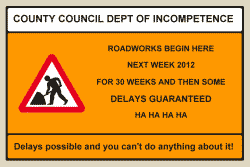A newly-qualified ADI recently mentioned that they were looking to go independent straight away, having just passed their Part 3. Their reasoning behind this was that if they didn’t have to pay a franchise, all the money they take from lessons would be theirs.
This is one of the main reasons new ADIs go out of business so quickly. I’ve covered this topic before, but it’s worth running through it again.
A Car
The first big mistake new ADIs make is to assume that you can somehow run a car for absolutely nothing! You can’t. Consider this…
You are a normal member of the public who decides that they want a new car for the family, and you decide that you’re going to pay £10,000 for it. You drive it away from the  showroom and park it on your driveway. If you keep it for three years, it is costing you £65 a week just to own it. At the end of three years its value will have approximately halved, and you use it as part-exchange on another new one costing £10,000. The bottom line is that for the first three years the car is costing you £65 a week, and after that the calculations get more complicated but the weekly cost gradually declines. If you always trade in after three years, and pay the same £10,000 for a new model, the absolute minimum the car will end up costing you is £35 a week (this is over-simplified, but you get the idea). And none of this includes insurance, which could easily be another £20 per week! So you cannot keep a car for nothing.
showroom and park it on your driveway. If you keep it for three years, it is costing you £65 a week just to own it. At the end of three years its value will have approximately halved, and you use it as part-exchange on another new one costing £10,000. The bottom line is that for the first three years the car is costing you £65 a week, and after that the calculations get more complicated but the weekly cost gradually declines. If you always trade in after three years, and pay the same £10,000 for a new model, the absolute minimum the car will end up costing you is £35 a week (this is over-simplified, but you get the idea). And none of this includes insurance, which could easily be another £20 per week! So you cannot keep a car for nothing.
A driving instructor has a few more boxes to tick when choosing a car, so the cost per week is always going to be a bit higher in many respects. To quote Hitachi Capital, who lease cars to driving instructors:
Purchasing an instructor vehicle outright might seem like an attractive option. However, when the real costs of running an instructor car are calculated, for many car leasing is a simpler, more cost effective route.
A driving instructor vehicle can typically do 30,000 miles per year and will often suffer more wear and tear than the average car.
Instructor vehicles tend to go through more tyres, clutches and brakes than normal – and many driving instructors underestimate the cost of repairs.
Repairs can be costly, not only in terms of garage bills, but also in terms of vehicle downtime. A vehicle off the road means cancelled lessons – and no income.
A franchise deal including a car will cost something in the region of £150-£200 per week. It’s basically a lease with extras, like advertising, diary management, all repairs, and pupil supply. It sounds like a hell of a lot of money, but all you have to then do is pay for fuel and give lessons.
Leasing a basic car will cost you at least £60 per week not including insurance, but a decent car is typically around £80-£100. All repairs are included. It will be entirely your responsibility to find work once you have the car. Note that leasing a car is only slightly more costly than buying one outright (in spite of the idiotic comments many ADIs insist on making about anything that has even a whiff of lease of franchise associated with it).
If you buy a car outright, wear-and-tear replacements are down to you, as is tax and insurance. And you won’t have a replacement car ready if yours breaks down.
Some Pupils
The next big mistake made by new ADIs (and some established ones) is to assume that  it is easy to get pupils. These instructors go through the qualifying exams assuming that once they have a green badge, learners will be queuing outside their door. The reality is a million miles away from that.
it is easy to get pupils. These instructors go through the qualifying exams assuming that once they have a green badge, learners will be queuing outside their door. The reality is a million miles away from that.
There are a lot of driving instructors out there, and they’re all looking for work – if not for today, definitely for tomorrow. So somehow, the new ADI needs to try and let people know he or she is there, too. And that means advertising. Fairly simple, right? Well, yes… and no.
An example: the smallest advert in Yellow Pages (other than a single line entry) will (or used to) set you back about £600 for a year (that’s another £10 a week). However, all those other instructors out there are also advertising, so you end up being just a small voice amongst many – some of whom are paying for full-page ads. From personal experience, I can absolutely guarantee that £600-worth of Yellow Pages advertising can easily generate absolutely no work whatsoever (and that was when YP was a thick, A4-sized book, and not the A5-ish pamphlet it has become today). And another drawback to advertising in Yellow Pages is that you’ll get dozens of calls from people trying to sell you phones, advertising, and all kinds of other crap – and it persists even years after you aren’t in it anymore!
What about those local free newsletters with “guaranteed circulation of 10,000”? Again, I can state categorically that £300-£400-worth of advertising (up to £7 a week) in one of those for three months may easily generate absolutely no work. It all adds up, so you may well end up spending £20-£30 a week on advertising for no return.
The latest fad is for people who have only just realised that technology exists to glibly  inform everyone that “a website is essential”. Well, it can certainly be useful, but when they say “essential” they mean for generating work – and in that sense they are wrong. Why? Well, just as Yellow Pages got flooded with driving instructors, so did the internet, and if you type “driving lessons” into Google for your area, once you’ve sifted through the big names – many of whom are abusing Google’s terms by appearing more than once under dubious search terms – you’ll realise that the likelihood of you appearing anywhere in the first 20 pages anytime soon is a bit of a long shot. Let’s face facts, here. It is impossible for everyone to appear in the Number 1 position on Google, no matter what the guy from Y***** P**** (or the people who got your name from them) promises you (and every other instructor) when he cold calls you repeatedly.
inform everyone that “a website is essential”. Well, it can certainly be useful, but when they say “essential” they mean for generating work – and in that sense they are wrong. Why? Well, just as Yellow Pages got flooded with driving instructors, so did the internet, and if you type “driving lessons” into Google for your area, once you’ve sifted through the big names – many of whom are abusing Google’s terms by appearing more than once under dubious search terms – you’ll realise that the likelihood of you appearing anywhere in the first 20 pages anytime soon is a bit of a long shot. Let’s face facts, here. It is impossible for everyone to appear in the Number 1 position on Google, no matter what the guy from Y***** P**** (or the people who got your name from them) promises you (and every other instructor) when he cold calls you repeatedly.
Now, I’m not saying that advertising, being in Yellow Pages, or having your own website doesn’t work. It does – in time, sometimes, with a bit of luck, and if you do it properly. But it is not a tap you can turn on and off just like that, and it’s expensive. And even if it gets you enough work for one moment in time, that work can easily dry up at any other moment.
A Special Offer
For some reason, every ADI who passes Part 3 seems to be under the impression that they will corner the market by advertising. Believe me, you won’t. And when reality dawns –  by which time you’ll probably already be struggling to make ends meet – you’re going to want to look for an angle that sets you apart from the crowd.
by which time you’ll probably already be struggling to make ends meet – you’re going to want to look for an angle that sets you apart from the crowd.
You’re not going to attract work by charging more than everyone else, so… hey, here’s a great idea! Why not cut your lesson prices to snag customers? Instead of charging £25 an hour, you can do £23 instead. Oh, but wait, there are already loads of others doing that so let’s try a bit lower – £20, say. Even that might not be enough to stand out, and you could end up going as low as £15 in an area others are still successfully charging £25.
Hold on, though. Here’s another great idea. Free lessons. Give away the first lesson free. Damn, people are already doing that, so let’s do a package and sell 10 lessons for something silly, like £99 – or even as low as £56.
Can you see what I’m getting at here? There are over 40,000 ADIs in the country, and the newly-qualified ADI is not special or unique. Far from it, in fact. A huge proportion of ADIs who got on the Register before you are already offering deals and trying to undercut each other. And is it working for them?
The short answer is no, it isn’t. There are instructors giving the job up all the time – not just new ones, but established ones who have been doing the job for years. It can be very area-specific, but even established instructors are finding it hard to get work – and more and more of them are joining franchises in order to survive even after many years of being independent.
So the question you have to ask yourself is: can I make it on my own when I’m just starting out when so many others cannot?
Your Bank Account
Let’s imagine you’ve gone with a franchise, that you’re paying £200 a week for it, and that you’re charging £23 an hour for lessons. Now let’s imagine that you’ve been running for a  few months and have between 20 and 30 hours of work. Your total turnover will be up to £690, which leaves you with about £290 after your normal overheads. That works out to a wage of around £15,000 a year.
few months and have between 20 and 30 hours of work. Your total turnover will be up to £690, which leaves you with about £290 after your normal overheads. That works out to a wage of around £15,000 a year.
Now let’s assume you chose one of the other options where you’re totally responsible for generating your own supply of pupils. You’re struggling to get 20 hours of work, and you’ve cut your price to £20, with a special offer of “10 or £99”. In a typical week at the moment, 5 of your 20 hours are therefore at the £9.90 rate. Your turnover is around £350, which leaves you with about £150 after normal running costs. You will also have to factor in anything you have spent on advertising, which will also come out of that £150. This equates to an annual wage of considerably less than £7,800, and you can knock off another £50 for every £1 per week you spend on advertising!.
Even if your scheme manages to bump up your diary to 30 hours your total weekly wage will still be less than it would be if you were franchised – about £200-£250. So for all that work – and 30 hours of lessons isn’t easy when you’re starting out – you’ll still be on less than around £12,000 a year.
Summing Up
Obviously, it is necessary to make a lot of assumptions when explaining this. My assumptions are realistic and based on reality, whereas the newly-qualified ADI unrealistically assumes that they can get as much work as they need as soon as they start trading. Honestly, it doesn’t work like that, and you need as much help as you can get for the first year at least – possibly for longer than that.
Let me make it absolutely clear that IF you can generate enough work, being independent is the cheapest option by a long way. But if you desperately need to make the job pay then it is extremely risky to choose that option right from the start. You really must not rule out a franchise on the naive assumption that the money you save will be all profit, because you simply won’t have the money to save in the first place!
 during the test.
during the test.
 bunch of toffee-nosed Hoorays dressing up in silly costumes and racing around the countryside.
bunch of toffee-nosed Hoorays dressing up in silly costumes and racing around the countryside. showroom and park it on your driveway. If you keep it for three years, it is costing you £65 a week just to own it. At the end of three years its value will have approximately halved, and you use it as part-exchange on another new one costing £10,000. The bottom line is that for the first three years the car is costing you £65 a week, and after that the calculations get more complicated but the weekly cost gradually declines. If you always trade in after three years, and pay the same £10,000 for a new model, the absolute minimum the car will end up costing you is £35 a week (this is over-simplified, but you get the idea). And none of this includes insurance, which could easily be another £20 per week! So you cannot keep a car for nothing.
showroom and park it on your driveway. If you keep it for three years, it is costing you £65 a week just to own it. At the end of three years its value will have approximately halved, and you use it as part-exchange on another new one costing £10,000. The bottom line is that for the first three years the car is costing you £65 a week, and after that the calculations get more complicated but the weekly cost gradually declines. If you always trade in after three years, and pay the same £10,000 for a new model, the absolute minimum the car will end up costing you is £35 a week (this is over-simplified, but you get the idea). And none of this includes insurance, which could easily be another £20 per week! So you cannot keep a car for nothing. it is easy to get pupils. These instructors go through the qualifying exams assuming that once they have a green badge, learners will be queuing outside their door. The reality is a million miles away from that.
it is easy to get pupils. These instructors go through the qualifying exams assuming that once they have a green badge, learners will be queuing outside their door. The reality is a million miles away from that. inform everyone that “a website is essential”. Well, it can certainly be useful, but when they say “essential” they mean for generating work – and in that sense they are wrong. Why? Well, just as Yellow Pages got flooded with driving instructors, so did the internet, and if you type “driving lessons” into Google for your area, once you’ve sifted through the big names – many of whom are abusing Google’s terms by appearing more than once under dubious search terms – you’ll realise that the likelihood of you appearing anywhere in the first 20 pages anytime soon is a bit of a long shot. Let’s face facts, here. It is impossible for everyone to appear in the Number 1 position on Google, no matter what the guy from Y***** P**** (or the people who got your name from them) promises you (and every other instructor) when he cold calls you repeatedly.
inform everyone that “a website is essential”. Well, it can certainly be useful, but when they say “essential” they mean for generating work – and in that sense they are wrong. Why? Well, just as Yellow Pages got flooded with driving instructors, so did the internet, and if you type “driving lessons” into Google for your area, once you’ve sifted through the big names – many of whom are abusing Google’s terms by appearing more than once under dubious search terms – you’ll realise that the likelihood of you appearing anywhere in the first 20 pages anytime soon is a bit of a long shot. Let’s face facts, here. It is impossible for everyone to appear in the Number 1 position on Google, no matter what the guy from Y***** P**** (or the people who got your name from them) promises you (and every other instructor) when he cold calls you repeatedly. by which time you’ll probably already be struggling to make ends meet – you’re going to want to look for an angle that sets you apart from the crowd.
by which time you’ll probably already be struggling to make ends meet – you’re going to want to look for an angle that sets you apart from the crowd. few months and have between 20 and 30 hours of work. Your total turnover will be up to £690, which leaves you with about £290 after your normal overheads. That works out to a wage of around £15,000 a year.
few months and have between 20 and 30 hours of work. Your total turnover will be up to £690, which leaves you with about £290 after your normal overheads. That works out to a wage of around £15,000 a year. Get one thing straight: if you become an ADI intending to make a living out of it, you do not turn work away needlessly, and you don’t just do what everyone else does (or says they do) – you make your own decisions. But where do you draw the line?
Get one thing straight: if you become an ADI intending to make a living out of it, you do not turn work away needlessly, and you don’t just do what everyone else does (or says they do) – you make your own decisions. But where do you draw the line? n accident in the first six months of driving – therefore the remaining 80% are totally safe and responsible.
n accident in the first six months of driving – therefore the remaining 80% are totally safe and responsible. ards Bingham, and got into Nottingham via the A46 and A6097 (it only took about 20 minutes going that way). The Nottingham-bound traffic was solid right back to the Bingham roundabout, suggesting that it extended even further back than that – so a jam of at least 6 miles in length.
ards Bingham, and got into Nottingham via the A46 and A6097 (it only took about 20 minutes going that way). The Nottingham-bound traffic was solid right back to the Bingham roundabout, suggesting that it extended even further back than that – so a jam of at least 6 miles in length.